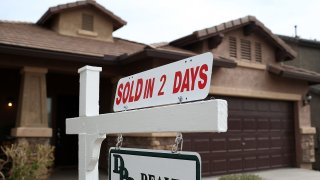
- Sales of previously owned homes in January rose 6.7% from December to a seasonally adjusted annualized rate of 6.5 million units, according to the National Association of Realtors.
- The supply of homes for sale fell to a record low, down 16.5% from a year ago.
- Tight supply and strong demand pushed the median price of a home sold in January to $350,300, an increase of 15.4% from January 2021.
Sales of previously owned homes in January rose 6.7% from December to a seasonally adjusted annualized rate of 6.5 million units, according to the National Association of Realtors. That exceeded Wall Street expectations significantly. Sales were 2.3% lower compared with January 2021.
The supply of homes for sale fell to a record low, down 16.5% from a year ago. There were just 860,000 homes for sale at the end of January. At the current sales pace it would take just 1.6 months to exhaust that inventory. A 4 to 6-month supply is considered a balanced market. That is also a record low.
"Seller traffic is very very low, implying that inventory is struggling to make the turn. Realtors are indicating multiple bidding wars are still happening," said Lawrence Yun, chief economist for the Realtors.
Get Connecticut local news, weather forecasts and entertainment stories to your inbox. Sign up for NBC Connecticut newsletters.
Tight supply and strong demand pushed the median price of a home sold in January to $350,300, an increase of 15.4% from January 2021.
That price is being somewhat skewed by the fact that the bulk of sales activity is on the higher end of the market. Supply is leanest on the low end. Homes priced between $100,000 and $250,000 were down 23% from a year ago, while sales of homes priced between $750,000 and $1 million rose 33%. Sales of homes priced above $1 million were up 39%.
Homes are also selling fast, with an average 19 days to go under contract. One year ago, when the market was also strong, days-on-market was 21.
Money Report
These sales are based on contracts signed in November and December, before mortgage rates began to rise sharply. The average rate on the 30-year fixed loan was around 3.2% during that time. Now it is just over 4%, according to Mortgage News Daily.
The share of sales made all in cash rose to 27% from 19% a year ago. Part of that may be due to a rise in the investor share to 22% from 15% a year ago.
"Investors are really popping out, and this may be why we're seeing a pop in home sales," said Yun.
"The major question is whether rising rates will quench housing demand that stems, in large part, from a demographic tidal wave of young households at key homebuying ages," said Danielle Hale, chief economist for Realtor.com. "Our expectation is that we'll continue to see home sales at a relatively high level throughout 2022, as post-pandemic shifts like rising workplace flexibility enable would-be buyers to expand their geographic search horizons and find an affordable place to call home."
Sales of newly-built homes, which are counted by contracts signed during the month not closings, jumped nearly 12% in December from November. Buyers are turning more to new construction because of the very low supply of existing homes for sale. Unfortunately builders are not keeping up with demand, as supply chain and labor issues slow production.






